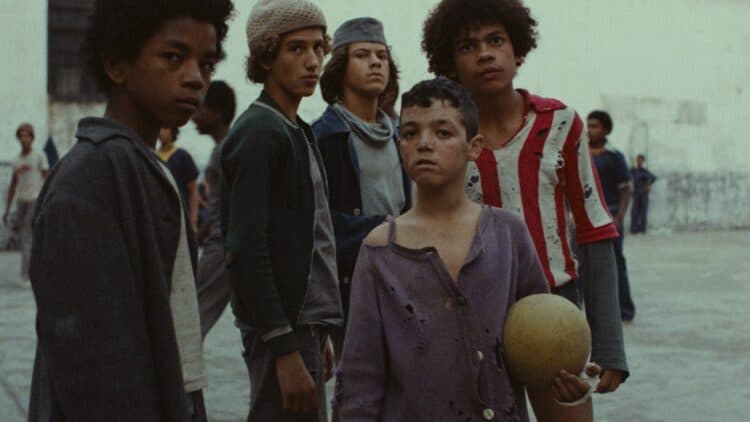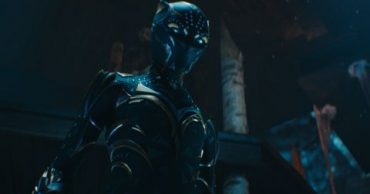
In 1980, Argentine filmmaker Hector Babenco would write, produce, and direct a film that would bring him international attention as well as serious scholarly study in future film studies, Pixote (pee-shot-e). This film explored in gritty, raw, and emotionally disturbing detail the lives and experiences of street children between the ages of 8-16 who have no viable choices but to succumb to adolescent lives filled with prostitution, drug dealing, robberies, and even murders. The film is heavily reminiscent of Italian neo-realism in that many of the young male actors matched the ages and experiences of the lives of the characters within the film. Scenes of disturbing sexual assault, prostitution, drug use, adolescent domestic violence, and child abuse presented to the world a harsh and raw depiction of a Brazilian reality that persists to the present day. This is a film that is both underrated, and also extremely disturbing, but its disturbing aspects are firmly rooted in reality. As a work of World Cinema, Babenco’s Pixote fulfills the traditional themes of reality and unflinching authenticity to lives and experiences that provide a sharp contrast to life in the Western world. Let’s take a closer look at this important film, and better understand why it deserves to be seen by all those serious about the art of filmmaking.
Hector Babenco
Hector Babenco was born in Buenos Aires, Argentina to a Polish-Jewish mother and an Argentine father on February 7, 1946. After experiencing a lower-middle-class childhood in his hometown, Babenco traveled to Spain in 1964 at the age of 18 where he would work as a movie extra which exposed him to the filmmaking process to which he would dedicate the rest of his career. In 1971, Babenco decided to settle in Sao Paulo, Brazil where he would begin experimenting with making short films that explored a variety of themes found in the disadvantaged and downtrodden citizens of his new hometown. Exploring themes about social classes, child abandonment, survival at any cost, inequality, corruption, and the toll that addiction, prostitution, and a life of crime take on people’s lives would become his signature trademark throughout his film career. In 1975, Babenco secured the financing that allowed him to make his first feature film called O Rei da Noite (King of the Night). This film has subsequently been lost to film deterioration but the success of the film was enough to secure funding for his second feature Lucio Flavio (1978) which depicted the experiences of a real-life bank robber that pulled off a successful strong high-profile bank robberies in Rio de Janeiro, Brazil throughout the 1970s. For the remainder of Babenco’s life, he would make films primarily set in the United States or in various parts of the world with first-world actors and characters. Films like Kiss of the Spider Woman (1985), which won William Hurt the Best Actor Oscar, and Ironweed (1987) would take the realism found in Pixote and explore the lives of the downtrodden and cast aside in America and American characters lost in the prison system of Third World countries. Hector Babenco died from cancer in 2016.
What Is the Film About?
Pixote was filmed on the streets of Sao Paolo and Rio de Janeiro, Brazil in 1979 and 1980. The film runs for two incredibly intense, concise, and unflinching hours. Pixote is a fictitious feature film that also blended the cinematic techniques of the documentary style known as cinema verité with cinematography and art direction that presents a muted, seemingly washed-out aesthetic that brilliantly captures the grim conditions of squalor found on city streets, prisons, and squatting sites. There is very little of a musical score in the film and the editing blends one powerful scene after the next in a seamless fashion. The film is filled with harsh scenes but the narrative is also filled with scenes that depict a quieter and almost harmonious communal experience between the incarcerated youth, prostitutes, drug dealers, and pimps who are looking for companionship and reassurance from one another as all humans of whatever social class or situation do. In terms of plot, the film is a narrative tracking shot with edits that shows a moment in time of characters trying to survive and express their understanding of a world that is filled with corruption and crime from law enforcement and the Brazilian system that ironically mirrors the same pursuits available to the disadvantaged youth who are crushed under a system that commits just as egregious and damaging crimes as the youth on the city streets and within the squalid prison camps.
The central protagonist of the film goes by the nickname of the film’s title (pee-shot-e) and is portrayed by eleven-year-old Fernando Ramos da Silva (1967-1987). Pixote is the eyes by which we view the film and we watch over the course of two hours how he is initially abused in the youth detention center but slowly becomes a more hardened and skilled criminal by the end of the film. He bonds with other youth in the detention center survives the rampant abuse of older youth in the prison, bonds with a prostitute/mother figure named Sueli (played with incredible emotional honesty by Marilia Pera), and slowly begins to lose his innocence to peer pressure and adapting to a life that he has no other choice but to adapt to. Fernando Ramos da Silva shows an incredible emotional range for a child of 11 with no acting experience, and much of this comes from his real-life up to that point being nearly identical to the survival skills needed at a young age to survive a life of poverty, just like Pixote. There is a moment in the film where Pixote is visited in the prison by his grandfather who tells him that it is “worse out here than where you are” (Pixote, 32:54). This allows the viewer to acknowledge that life in Sao Paolo for the poor and disadvantaged living under a corrupt system is the real antagonist of the film; crime and growing up fast is the first-world equivalent of going to elementary school and listening to your parents.
The Film Has No Agenda
There are no “pure” and “moral” models of inauthentic affluence and comfort that mirrors the system of adolescence in first world countries—this is the reality of a life that adolescents should not have to endure, but that is the normal course of action in cities as corrupt as Sao Paulo, Brazil in the late-1970s. One scene in the film is truly hard to take, as it depicts prison wardens who are likely told by the Sao Paulo judicial system to round-up a selection of young boys, drive them to a desolate area, tell them to get out of the van, and start running, and then subsequently murders the boys in cold blood to be filed as inmates attempting to escape. To think that this was/is likely a reality as a heartless way to curb youth violence and crime is stomach-churning, but Hector Babenco never pulls the camera away as the boys are murdered–he shows every single detail to the viewer (Pixote, 36:00). Furthermore, witnesses to crimes simply show up to line-ups, pick a youth that “looks like” the perpetrator, and the detectives accept this as proof that they were the perpetrators of a crime.
The second half of the film takes place in Rio de Janeiro as we follow Pixote and some of his companions after they escape from the prison. Life on the streets of Rio is rough and uncompromising for homeless street kids with no chances of entering an unjust and class-based capitalist society. Pixote, Lilac, and Dito meet up with a prostitute named Sueli where they become her pimps and assist her with protection and robbing the wealthy, married men that she solicits for sex. Sueli is older and recovering from a self-inflicted abortion that she performed on herself in her bathroom. Sueli provides a type of motherhood to the boys that have always been missing from their lives. The film concludes with a botched robbery between Sueli, Pixote, and Dito. Pixote accidentally shoots and kills Dito and then his original target–an American tourist that was with Sueli. The final scene depicts a grief-stricken Sueli comforting Pixote who begins to suckle her breasts as if he were still a baby; disillusioned with her life and her previous abortion, Sueli rejects Pixote and tells him to leave. The final frame shows Pixote walking down a railroad track before disappearing into an unknown future.
Hector Babenco, like the Third Cinema pioneers of Latin America in the previous two decades, sought to make a film that showed an uncompromising and honest portrayal of life for homeless street youth and other disadvantaged individuals who have no choice but to try and survive inside a broken system. The film does not moralize and is devoid of self-righteousness; Babenco follows a direct and incisive narrative that doesn’t attempt to persuade or seek sympathy—it just is. One of the most profound aspects of Latin American Third Cinema is the degree of respect that filmmakers had for audiences. Pixote is one of those films that never attempts to tie up a loose end or provide a false happy ending–because life itself is never so forgiving or easily lived. If the film seems bleak, that’s because the reality it is depicting is extremely bleak.
There are some incredibly difficult scenes to watch in the film, but what Babenco is truly representing with this film through the filter of Third Cinema is that can you overcome your life of affluence and general comfort to allow yourself to see and feel what life is like for people living inside of a horribly corrupt system in a nation from the Third World? One of Sueli’s johns is an older American tourist and to me, that represented Babenco’s way of showing the soullessness and consumerist mindset that many Americans often exhibit when they think about or visit nation’s that have rapid systemic crime and inequality. The tourist uses Sueli like a transaction to fulfill his own pleasure, and the squalid living conditions of her apartment find the tourist remarking of how turgid and nasty it is; reducing Sueli to a piece of meat to prop up his own manhood and ethnocentric bias through sex is a symbolic representation of the corrupt system that crushes the poor and disadvantaged of Sao Paulo and Rio de Janeiro. If it isn’t happening to you and doesn’t reflect your own life, why care? That is the primary problem with the government and social class system in these cities in the film–nobody cares because as long as these people exist and stay within the prison industrial complex, the lives of the overseers maintain a sense of affluence and comfort.
Legacy and Tragedy
I chose to review this film because I think it truly adheres to the ideals set out by Latin American Third Cinema pioneers in the 1950s and 1960s. What Hector Babenco archives with this film is the cruelest and most hellish slice-of-life that goes far beyond the bourgeois pretentiousness that was saturating much of Second Cinema in the 1970s, and the mainstream frivolity of First Cinema. Third Cinema is all about continuing and evolving the Italian neo-realist style and an almost guerilla-like style of gritty and realistic filmmaking. Pixote is a rough experience, but for the youth that inhabits the film–it’s daily life, not a cautionary tale. Fernando Ramos da Silva would gain some notoriety and attention after his role as Pixote, but in 1987, in a cruel and ironic twist-of-fate, he was murdered by Sao Paulo police under mysterious circumstances that are believed to have been covered up by local law enforcement; he was 19 years old. Life imitates art and art imitates life. Pixote is an important film in cinema history. It sometimes gets lost due in part to its being a foreign film, perhaps because of its disturbing narrative, but to miss this film is to miss an example of filmmaking that is hard to take, but also rewarding in its honesty.
Pixote is currently available to stream on The Criterion Channel.
 Follow Us
Follow Us





